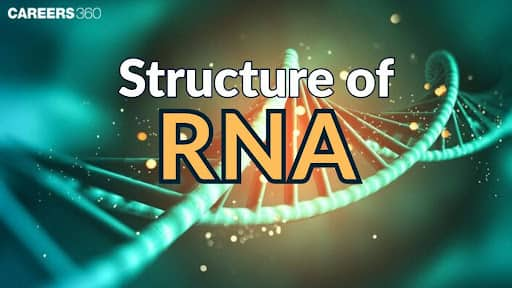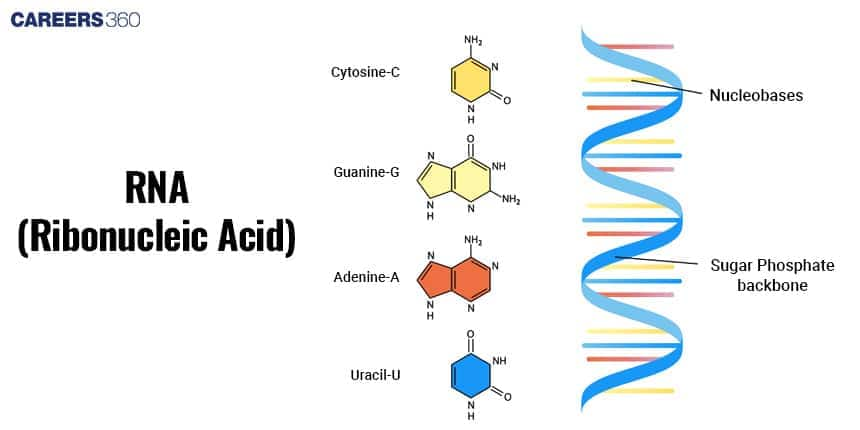Structure of RNA: Know Functions and Types
RNA or Ribonucleic acid carries genetic material. Unlike DNA, RNA is single-stranded and contains ribose sugar and the nitrogenous base uracil instead of thymine. Understanding the structure of RNA helps to know how genetic instructions are decoded in cells. It plays a central role in the molecular basis of inheritance, acting as the messenger between DNA and proteins.
- What is RNA?
- Basic Structure of RNA
- Levels of RNA Structure
- Types of RNA
- Function of RNA
- Recommended Video on Structure of RNA
- MCQs on RNA

Studying the structure of RNA is important not only for understanding genetics but also for its applications in biotechnology principles. The knowledge of RNA structure has helped in the development of such as RNA-based vaccines and gene therapies, highlighting its significance in research and medicine.
What is RNA?
RNA is one of the most important biological molecules. It helps in major functions like coding, decoding, regulating, and expressing genes. Unlike DNA, which gets support from the double strands and hence only stores genetic information. Most of the RNA is single-stranded and participates in protein synthesis and other cellular activities. It was discovered in the 20th century, but its structure and functions were clearly understood later through research.
It is one of the central elements of the central dogma of molecular biology, which explains the flow of genetic information from DNA to RNA and finally into proteins. RNA mainly acts as a messenger, carrying the instructions from DNA to protein synthesis. It has several other forms that help in making proteins, catalyzing reactions, and controlling gene activity inside the cell.
Basic Structure of RNA
RNA is a type of nucleic acid that carries genetic information. It is synthesised from small units called nucleotides. It is generally single-stranded and found in the nucleus as well as cytoplasm of the cells. RNA helps to synthesize proteins and controls cellular processes. It has a flexible structure which allows it to take different shapes and functions based on the needs of the cell.
Nucleotides
Nucleotides are building blocks of RNA. A nucleotide is made up of a sugar molecule known as ribose, a phosphate group, and one nitrogenous base. Unlike the deoxyribose sugar of DNA, the ribose sugar of RNA contains an additional hydroxyl group. This makes a difference in stability and makes RNA different in function. This is one of the main differences between RNA and DNA.
Nitrogenous Bases
There are four types of nitrogenous bases in RNA: Adenine A, Guanine G, Cytosine C, and Uracil U. These are held by hydrogen bonds and form specific base pairs. Adenine is paired with Uracil (A-U) and Guanine is paired with Cytosine (G-C). This base pairing is important for secondary structure and function in RNA.
Phosphodiester Bonds
The phosphodiester linkage refers to the sugar-phosphate backbone that holds the RNA together. Besides, these join the 5' phosphate group of one nucleotide to the 3' hydroxyl group of the succeeding nucleotide, thus forming a continuous chain with direction from the 5' to the 3' end. This is very important in the process of transcription and translation.
Levels of RNA Structure
RNA has three levels of structure: primary, secondary, and tertiary. These levels help RNA fold and function properly on the cell. Each level has a role in gene expression and cellular processes.
Primary Structure
The primary structure of RNA is the simple linear sequence of nucleotides. This sequence determines the properties of genetic material, RNA. It plays a key role in accurately transferring genetic information.
Secondary Structure
The secondary structure forms when complementary bases form by hydrogen bonding, forming motifs such as stem loops or hairpins. These structures prevent degradation and favor the stability of the RNA, allowing it to form compact shapes.
Tertiary Structure
The tertiary structure refers to the three-dimensional shape formed by folding of the secondary structure of RNA. The examples include, the cloverleaf structure of tRNA and the folding of rRNA inside the ribosome. These complex shapes allow RNA to perform various activities within the cell.

Types of RNA
RNA exists in different types and each type has a specific role in the cell. The main types of RNA include mRNA, tRNA, and rRNA. These work together in the protein synthesis. There are some other types of RNA as well that help in gene regulation and other activities.
tRNA (Transfer RNA)
Transfer RNA carries specific amino acids to the ribosome during the process of translation. It matches its anticodon with the codon on mRNA to ensure the correct amino acid is added to the growing protein chain.
rRNA (Ribosomal RNA)
Ribosomal RNA provides a main structure of the ribosome. It helps read the mRNA and connect tRNA to translate genetic information into the amino acid sequences.
mRNA (Messenger RNA)
Messenger RNA bears genetic information from DNA to the ribosome. It acts as a template for the protein synthesis. Before translation, it undergoes certain events like capping, polyadenylation, and splicing processes to become mature mRNA.
Function of RNA
RNA plays many important roles within the cell. It is involved in the processes of gene regulation and gene expression. Each type of RNA molecule has a unique and essential function in the process of gene expression and regulation.
mRNA Function
Messenger RNA is made during transcription . The mRNA undergoes processing, which includes the addition of the cap at the 5′ ends and the formation of the poly-A tail at the 3′ ends, and splicing to remove the introns. The mature mRNA then serves as a template for the transfer of the genetic code across to the ribosome for translation into protein.
tRNA Function
Transfer RNA (tRNA) helps translate mRNA into protein. Each tRNA molecule holds an anticodon that recognizes a particular codon in the mRNA strand, ensuring the correct amino acids are incorporated into the growing polypeptide chain.
rRNA Function
Ribosomal RNAs (rRNA) are major constituents of the ribosomes, which are cellular machines for protein synthesis. It ensures the correct alignment of mRNA and tRNAs and catalyses the joining of amino acids through peptide bonds. Proper and efficient generation of proteins depends on rRNA.
Other Non-Coding RNAs
Apart from these three RNAs, a large number of RNAs are non-coding and involved in regulatory functions. MicroRNAs (miRNA) and small interfering RNAs (siRNA) are involved in gene regulation. They can block or reduce the process of translation of certain mRNAs, helping regulate cellular functions.
Recommended Video on Structure of RNA
MCQs on RNA
Q1. Which of the following statements are incorrect:
i. RNA act a genetic material as well as a catalyst
ii. RNA is more stable than DNA
iii. RNA has evolved from DNA
(i) and (iii) only
(ii) and (iii) only
(i),(ii) and (iii)
(i) and (ii) only
Correct answer: 2) (ii) and (iii) only.
Explanation:
The importance of RNA -RNA was the first genetic material. Essential life process - metabolism. RNA is used to act as a genetic material as well as a catalyst. RNA being a catalyst was reactive and hence unstable.
RNA was the first molecule of heredity, so it evolved all the essential methods for storing and expressing genetic information before DNA came onto the scene. However, single-stranded RNA is rather unstable and is easily damaged by enzymes.
Hence, the correct answer is option 2) (ii) and (iii) only.
Q2. Which type of RNA is used to carry genetic information copied from DNA?
mRNA
snRNA
rRNA
tRNA
Correct answer: 1) mRNA.
Explanation:
Messenger RNA (mRNA) is the type of RNA that contains genetic information that has been copied from DNA. Transcription is the process by which DNA is converted into mRNA when a cell wants to produce a protein. After that, the mRNA moves to the ribosomes in the cytoplasm from the nucleus which houses the DNA. The ribosomes construct proteins using the information contained in the mRNA. Thus, mRNA serves as a messenger, transporting the genetic instructions from DNA to the cell's protein-making locations.
Hence, the correct answer is option 1) mRNA.
Q3. Which RNA carries the amino acids from the amino acid pool to mRNA during protein synthesis?
rRNA
mRNA
tRNA
hnRNA
Correct answer: 3) tRNA.
Explanation:
Transfer RNA or tRNA is crucial for the creation of proteins. During translation, it transports amino acids to the mRNA from the amino acid pool. An anticodon is a unique component of each tRNA molecule that aligns with the mRNA's codon. This makes it more likely that the protein being produced will include the appropriate amino acid.
Hence, the correct answer is option 3) tRNA.
Also Read:
Frequently Asked Questions (FAQs)
RNA is a single stranded molecule made of nucleotides. Each nucleotide includes a ribose sugar, phosphate group, and nitrogenous base (A, U, G, C)
RNA is formed in the nucleus of eukaryotic cells during transcription using DNA as a template.
Ribosomes contain ribosomal RNA, which helps in protein synthesis.
RNA carries genetic information from DNA to ribosomes and helps in synthesis of proteins.
RNA structure is used in vaccine development, gene regulation, and understanding molecular biology processes like splicing and translation.
Also Read
24 Jul'25 06:47 PM
24 Jul'25 12:41 PM
24 Jul'25 12:14 PM
24 Jul'25 11:56 AM
24 Jul'25 11:33 AM
24 Jul'25 11:16 AM
23 Jul'25 07:16 PM
23 Jul'25 07:08 PM
23 Jul'25 07:01 PM
